Right-Angle Beamsplitter Mounts for 30 mm Cage Systems
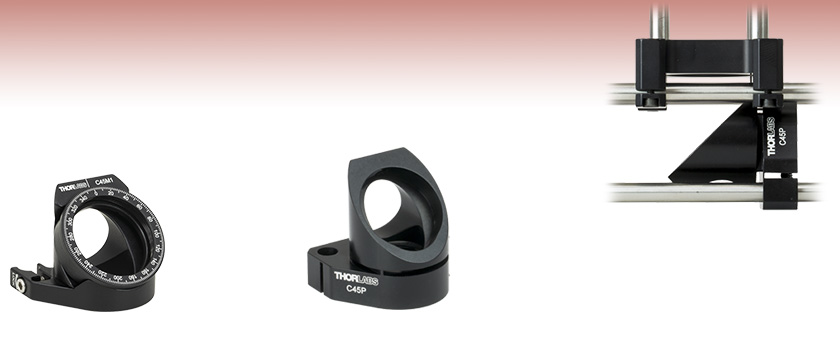
- Split a Beam at 90° with Ø1" Beamsplitters or Dichroic Mirrors
- Available with Kinematic Tip/Tilt or Rotation
- 30 mm Cage System Compatible
C45P
Kinematic Mount
±1° Tip and Tilt Adjustment
Application Idea
Split a beam at 90° using the C45P Right-Angle Kinematic Cage Mount and create a perpendicular arm with the CP30 Right-Angle Cage Adapter.
C45M1
Nested Rotation Mount
360° Optic Cell Rotation

Please Wait
Features
- Mount Ø1" Optics at a 45° Angle to the Cage System's Optical Axis
- Kinematic Mount for Tip and Tilt Adjustment
- Rotation Mount with Nested Optic Cell for 360° Adjustment
- 30 mm Cage System Compatibility
These Right-Angle Beamsplitter Cage Mounts secure a Ø1" optic within a 30 mm cage system at a 45° angle to the optical axis. Both mounts have two through holes at 90° for perpendicular transmitted beams. The C45P mount incorporates a flexure mechanism that provides ±1° of kinematic pitch and yaw adjustment. The C45M1 incorporates a nested optic cell that provides 360° of rotation adjustment.
The C45P is ideal for mounting transmissive optics like beamsplitters and beam samplers. The kinematic pitch and yaw adjustment can direct the reflected or transmitted beam to center the beam in a cage system or direct the beam to a specific target. The C45P secures the optic with a 5/64" (2.0 mm) nylon-tipped setscrew and features two 6.0 mm through holes with locking setscrews for cage rods to pass through.
The C45M1 can be used to rotate optics mounted at 45° in a cage system. The mount rotates in the 45° plane. The rotation mount can be used to mount wedged compensation plates to correct for angular deviation in the beam introduced by wedged optics upstream. The C45M1 can also rotate polarizing plate beamsplitters to align the reflected and transmitted polarization states relative to the cage system. The SM1-threaded, nested optic cell is removable to allow for quick optic changes, and the flexure locks allow the mount to snap into existing cage systems.
| Posted Comments: | |
Vincent Mall
(posted 2023-08-11 18:24:32.52) Hi, I was wondering if there is anything similar to the C45P with regards to the cage mounting, just with accomodation for elliptical mirrors to maintain the circular aperture for 90deg corners? The H45E1 and KC1L combination is a bit too bulky for my application. Did i miss something or is there simply none?
Kind regards jdelia
(posted 2023-08-17 11:20:24.0) Thank you for contacting Thorlabs. We unfortunately do not have a more compact solution at this time. However, I have forwarded your request to our design engineers via our internal suggestion forum for consideration as a future product. Tristan Fleming
(posted 2022-01-11 15:29:18.407) Can you please provide TPI on the +/-1 deg. tip/tilt adjustment for the C45P? 13 mrad/rev? jgreschler
(posted 2022-01-21 03:55:09.0) Thank you for reaching out to Thorlabs. The resolution for each axis is 28.8mRad/rev for the yaw adjuster, 10.9mRad/rev for the pitch adjuster. Wance Wang
(posted 2020-01-08 12:27:40.6) Hi, I am building parallel/diagonal 30mm cages (2 30mm cages sharing 2 or 1 common rods) using right angle mirrors. But your C45P often overlaps with each other, which causes troubles.
1. When C45Ps get closer in parallel cages, the mounting part to cage overlaps with the 45 mirror mounting head of another C45P. When using diagonal cages, the mounting part to cage overlaps with the small modulation platform. It's hard to explain clearly without pictures so you may see this https://photos.app.goo.gl/8tQqiFr89hx4yzzQ8.
2. Do you have a fixed 45 deg mirror mount? I don't need a kinematic one and C45P has the above problems. H45+CP35 is good but it can't be integrated with a vertical arm CP30 as C45P does. KCB1C is kinematic and one can't slide it along a cage. So a H45+CP35 combination with a mounting method like C45P is perfect.
I would appreciate it if you have interests in improving those aspects. It benefits to the building of a cage periscope using C45P-like elements. Thank you. YLohia
(posted 2020-01-08 05:03:54.0) Hello, thank you for contacting Thorlabs. It seems as thought the H45 and CP06F might work for you. Another option would be just using the CP360R locked to the 45 deg position. I have reached out to you directly to discuss your requirements in more detail. Mehdi Kazemi
(posted 2019-12-03 13:41:06.513) Could you also provide vacuum compatible version of this product?
Than you! llamb
(posted 2019-12-03 03:12:08.0) Thank you for contacting Thorlabs. A custom unanodized version of the C45P should be feasible to produce and allow for usage at moderate vacuum levels. I have reached out to you directly to discuss a possible custom quote. sasha
(posted 2018-08-30 05:43:01.4) We found a problem when using C45P mirror mount if we want to move its position along cage rods. Each position change requires to make a new angular adjustment.
Do you have any ideas for how to improve the "stability" of the C45P within a cage system ? llamb
(posted 2018-09-17 06:08:42.0) Thank you for your feedback. While not designed so much as a translation stage, the C45P should hold its kinematic position as the adjustment screws will not move. There may be a few sources affecting this consistency however, such as varying locking of the mount on the cage rods. I have reached out to you directly to troubleshoot further. |

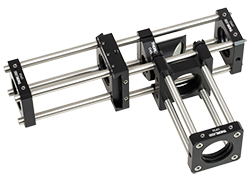
Click to Enlarge
Figure G1.2 In this 90° cage system setup, the incoming beam enters from the right side. The beam transmitted by the beamsplitter in the C45P mount undergoes an offset. This is corrected for by the CPX1(/M) Translating Cage Segment Plate.
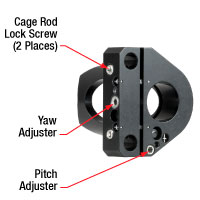
Click to Enlarge
Figure G1.1 All Setscrews Have 5/64" (2.0 mm) Hex
- Mount Ø1" Optics at a 45° Angle to the Cage System's Optical Axis
- Kinematic Mount with Flexure Design for ±1° Tip and Tilt Adjustment
- 30 mm Cage System Compatibility with Two Ø6.0 mm Through Bores
- Maximum Clear Aperture for Beamsplitting: Ø0.58" (14.8 mm)
- All Setscrews Feature a 5/64" (2.0 mm) Hex

Click to Enlarge
Figure G1.3 Beam Deviation Due to Parallel Optic at 45°
Thorlabs' C45P Right-Angle Flexure Mount secures a Ø1" optic within a 30 mm cage system at a 45° angle to the optical axis. The mount incorporates a flexure mechanism that provides ±1° of kinematic pitch and yaw adjustment. The pitch and yaw axes are actuated using two adjustment screws that are shown in Figure G1.1. Note: the kinematic adjustment screws should not be overdriven past the ±1° hard stops. Doing so may severely damage the flexure mechanism.
A nylon-tipped setscrew is used to secure the optic in the mount's double-bored hole. The minimum thickness for optics that can be secured by these mounts is 0.12" (3.0 mm). An optic spacer is necessary to mount optics thinner than 0.12" (3.0 mm). The screws for optic retention, kinematic adjustment, and cage rod locking can all be actuated using a 5/64" (2.0 mm) hex key or balldriver (sold separately).
Transmissive optics like beamsplitters and beam samplers will refract the transmitted beam as illustrated in Figure G1.3. A CPX1(/M) Translating Cage Segment Plate can be used in conjunction with the C45P to compensate for the offset of the beam as shown in Figure G1.2.
Many of Thorlabs' beamsplitters feature a 30 arcmin wedge to minimize ghosting effects. This wedge causes the transmitted light to exit the beamsplitter along a path that is not parallel to the cage system axis, as seen in Figure G2.2. To correct for this angular deviation while maintaining the alignment of the reflected beam, we recommend using a beamsplitter compensation plate, which can be mounted in a C45M1 Rotation Mount, sold below, for full angular control. The CPX1(/M) Translating Cage Segment Plate can then be used to recenter the cage system around the beam, which will have experienced a lateral offset caused by the thickness of the optics. For more details on this configuration, see below.

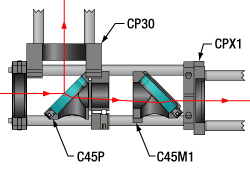
Click for Details
Figure G2.2 In this 90° cage system setup, the incoming beam enters from the right side. The beam transmitted by the wedged beamsplitter in the C45P mount undergoes a lateral offset and an angular deviation. The angular deviation is corrected for by the rotation of the compensation plate in the C45M1. The CPX1(/M) Translating Cage Segment Plate compensates for the offset.
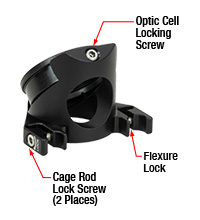
Click to Enlarge
Figure G2.1 All Setscrews Have 5/64" (2.0 mm) Hex
- Rotate Ø1" Optics at 45° in a Cage System
- Nested Optic Mount Allows Quick Optic Changes
- Mount Optics up to 0.20" (5 mm) Thick
- Flexure Lock Securely Clamps to Cage Rods
- Maximum Clear Aperture for Beamsplitting: Ø0.44" (11.2 mm)
- All Setscrews Feature a 5/64" (2.0 mm) Hex
Thorlabs' C45M1 Right-Angle Nested Rotation Mount secures a Ø1" optic within a 30 mm cage system at a 45° angle to the optical axis. The rotating optic cell allows for 360° of rotation to correct for angular offsets in the transmitted beam, such as those created by the 30 arcmin wedge in some plate beamsplitters.
An included SM1RR retaining ring is used to secure the optic in the mount's threaded hole. The maximum thickness for optics that can be secured by these mounts is 0.20" (5.0 mm). The flexure locks allow the mount to be slipped into an existing cage system and snapped into place. Note that the optic cell must be removed before inserting the mount into a cage system. The optic cell can be secured in the mount after the mount has been locked to the cage rods. The screws for locking the optic cell and the cage rods can all be actuated using a 5/64" (2.0 mm) hex key or balldriver (sold separately).
Most Thorlabs beamsplitters feature a 30 arcmin wedge to minimize ghosting effects. This wedge causes the transmitted light to exit the beamsplitter along a path that is not parallel to the cage system axis as shown in Figure G2.2. The rotating optic cell in the C45M1 allows the angle created by the wedge to be controlled and redirected. To compensate for the angle introduced by a wedged optic, we recommend using the C45M1 with a beamsplitter compensation plate in conjunction with a C45P, sold above. The C45M1 should be placed immediately downstream of the C45P as shown in Figure G2.2. The C45M1 can be rotated to redirect the beam to be parallel with the cage axis. The CPX1(/M) Translating Cage Segment Plate can then be used to recenter the cage system around the beam, which will have experienced a lateral offset caused by the thickness of the optics.
 Products Home
Products Home















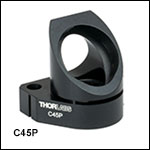
 Zoom
Zoom
 Right-Angle Beamsplitter Mounts
Right-Angle Beamsplitter Mounts